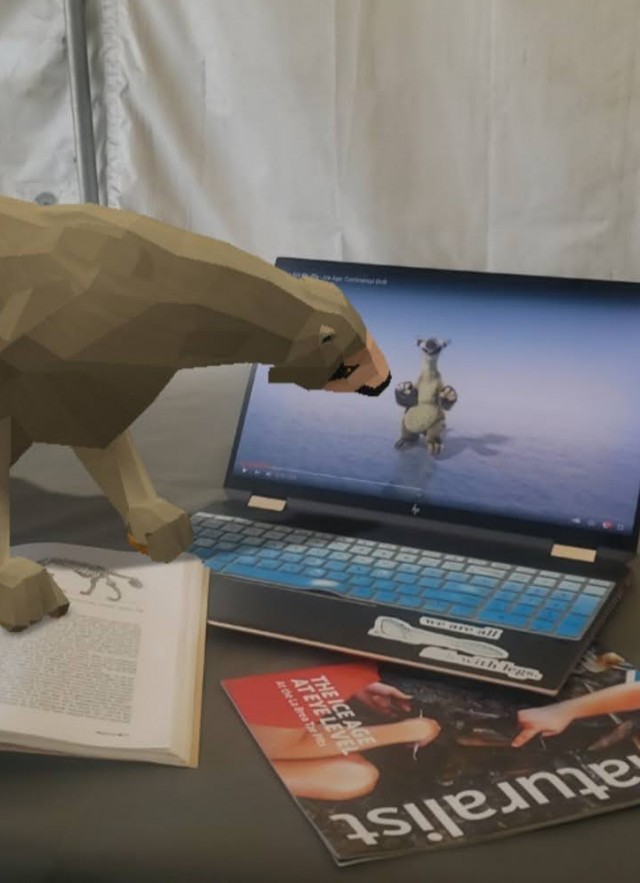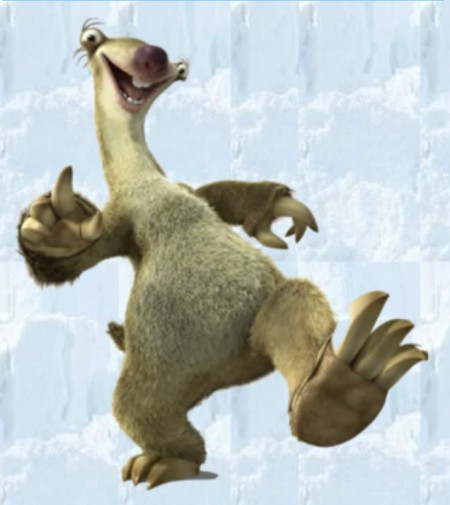What kind of giant sloth is Sid from the Ice Age movies?
Our paleontologists get to the bottom of Sid the giant sloth’s species

A 3D virtual model of an Ice Age sloth examines Sid, the Sloth from the Ice Age movies.
Published June 10, 2024
When it comes to extinct animals, Hollywood likes to exaggerate. Everything is bigger, badder—and when it comes to Sid from the animated Ice Age movies—both stranger and not quite strange enough to match reality.
Three Kinds of Giant Sloths
There are three kinds of giant sloths found at La Brea Tar Pits: Harlan’s ground sloth (Paramylodon harlani), Shasta ground sloth (Nothrotheriops shastensis), and Jefferson's ground sloth (Megalonyx jeffersonii). All three were giants by our standards, especially when compared to their closest living relatives, the much smaller two and three-toed tree sloths.
Sid’s bio claims that he’s based on Megalonyx, the least commonly found sloth at the Tar Pits. But we’re first and foremost a scientific institution, and some things about this cartoon sloth just don’t hold up to the fossil evidence.

What species of sloth is Sid?
Since Dreamworks hasn’t handed over a skeleton or any DNA samples, paleontologists Dr. Emily Lindsey, Curator of La Brea Tar Pits, and Dr. Matt Davis, Exhibit Developer, relied on Sid’s looks and movements to determine Sid’s species—a task they were prepared for having previously developed a series of scientifically accurate 3D models of Ice Age animals—including two of the ground sloth species found at the Tar Pits.
Emily: Megalonyx jeffersonii, the Jefferson’s ground sloth? No way! He’s too skinny. Megalonyx weighed over 2,000 lbs.
Matt: Yeah, that seems wrong to me, too. He’s too small. Compare him standing next to Manny, the woolly mammoth in the Ice Age movies. Woolly mammoths were, what, 10ish feet tall? Sid’s only half that making him 5–6 feet long. Megalonyx was more in the 10 ft length range. I think Sid is a Shasta ground sloth (Nothrotheriops shastensis).
Emily: Yes, a Shasta ground sloth! That makes sense. We’ve found a few fossils of Megalonyx at La Brea Tar Pits but the smaller Shasta ground sloth is much more common.
Matt: Emily and I have thought a lot about what different extinct animals would have looked like. We even made animated 3D models of many of the species found at the Tar Pits. Sid’s color and general shape are surprisingly close to our scientific model of the Shasta ground sloth.
Emily: Yeah, those are things we are actually pretty sure of because paleontologists found a Shasta ground sloth with dried-up skin and fur still on it preserved in a cave in New Mexico. We also have preserved Nothrotheriops hair from caves in Nevada and the Grand Canyon.

Matt: Sid’s claws are pretty accurate, too, but the way he walks isn’t quite right. Sloths could stand up on their back feet like he does, but they didn’t walk around on two feet all day.
Emily: These sloths actually walked on their front knuckles and the sides of their back feet, a really strange way of walking that you can see in our animated model. They also probably walked a lot slower than Sid is depicted. Ground sloths were so weird!
Matt: But not weird enough to have big bug eyes on the side of their head like Sid, haha.
Emily: Yeah, those aren’t sloth eyes. Those are more like the eyes on [thinks]…a frog?
Matt: A hammerhead shark?
Emily: Haha, yeah, Sid the Hammerhead!

The Strangest Strut
There you have it: according to our giant sloth experts, Sid is most likely a Shasta ground sloth. And while he’s certainly strange, there’s nothing on Earth that moves like giant ground sloths did. Explore the weird way these extinct giants walked using the sides of their back feet in the low poly model below.
